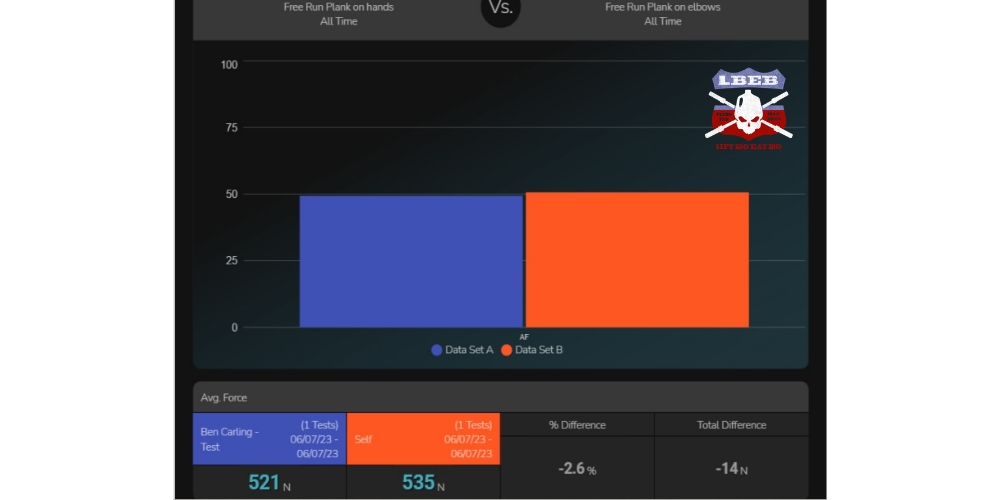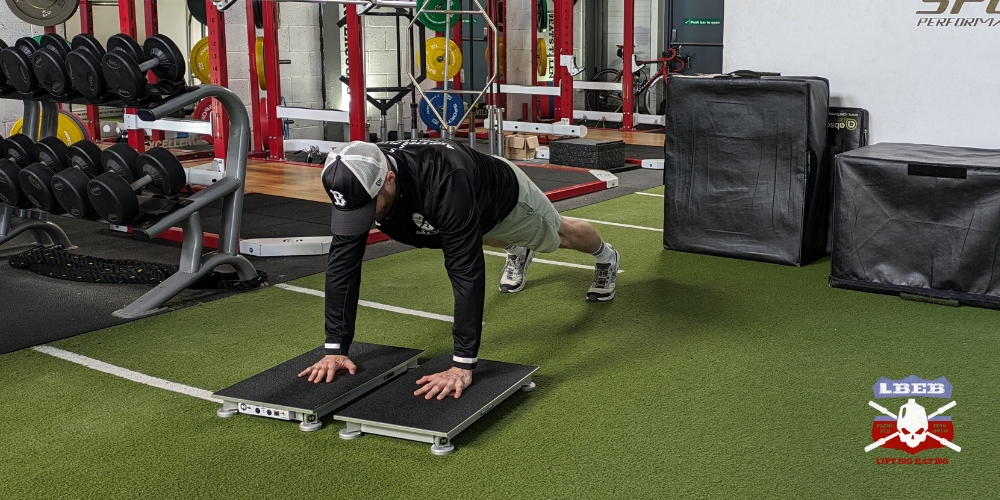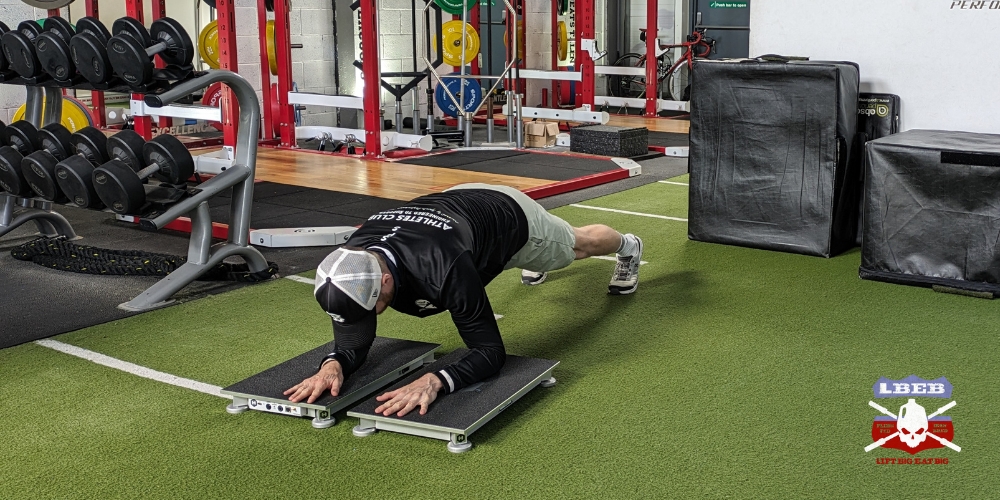When I started training many years ago, someone told me, “To strengthen your core, you need to do planks.” So I did. But I also remember feeling it on my shoulders and wondering whether I was doing it wrong.
Of course, experience and research (and common sense) tell us that the shoulders are an integral part of the exercise, whether planking on hands or elbows.
Contrary to popular belief, and looking at the force plate data, the plank on elbows is harder than the plank on hands as more force is generated through the shoulders and torso.
Does this mean you should always perform your planks on your elbows? Or are there other benefits associated with the plank on hands?
Table of Contents
Is The Plank On Hands Or Elbows Harder?
When we consider force application, the plank on elbows variation is considered harder to perform as there is more load to be tolerated through the shoulders. When you go to a hands position, you elevate your torso higher than your feet, thus reducing some of the load away from your shoulders.
This is evidenced in the force plate data I took of myself performing the two plank variations:
- Plank on hands = 521 N of force (117 lbs)
- Plank on elbows = 535 N of force (120 lbs)

I weigh 78 kg, so these numbers are relevant to my body weight and will differ from person to person. However, the principle remains the same.
Considering the neuromuscular side of the argument, plank on hands is a little harder for a different reason.
Due to the smaller surface area involved, there is more reliance on balance to keep you in position. Thus, your shoulders are working harder in terms of proprioception. Plank on hands wins round 2!
How To Plank On Hands
- Start by getting into a push-up position. The feet should be hip-width apart.
- Your hands should be directly underneath your shoulders to support your body weight.
- Your ankles, hips, and shoulders should form a straight line. Don’t allow your hips to collapse towards the floor, which can increase pressure on your lower back.
- Plank on elbows requires your elbows to be positioned directly under your shoulders.
- Engage your core by drawing your belly button towards your spine and tensing (as if you are about to be hit in the stomach by Mike Tyson).
- Remember to breathe. Hold for the required duration.
Plank On Hands Benefits

A Safe Exercise
Beginners often include planks in their training program, as no external loads or weights are involved. They are generally a static exercise which means they are easy to perform with minimal setup considerations.
Good All Year Round, No Matter Where You Are In Your Training Cycle
The likelihood of plank-related injuries is extremely low, and they are easily adapted to suit the desired outcome of your training program.
Good For Core And Shoulder Stability
To maintain an optimal plank position, your lower and upper abdominals, obliques, and shoulders must stabilize your body weight. If they don’t, you will likely drop your hips toward the floor or cannot hold your upper body off the floor in the desired position.
Can Be Adapted To Make Them Easier Or Tougher
Progressions and regressions are relatively easy to do. The most straightforward change is to hold the plank longer. You can advance further by removing one hand or foot off the floor to make it a 3-point plank and, in turn, further, challenge your core and shoulder stability.
Can Be Made Dynamic For Sports Performance
Athletes may require additional stressors depending on their sport. You can add movements into planks that still require high levels of core and shoulder stability. For example, you could include single-arm banded rows (adduction) or knee tucks (hip flexion) to make them more dynamic.
Plank On Hands Require No Equipment And Minimal Space.
You can perform a plank anytime, anywhere. Remember the craze a few years ago – The Plank Challenge? People performed planks in various places, from the gym to the forest!
Plank On Hands Cons
Less Activation Through The Shoulders And Core Muscles
The plank will produce less force when comparing planks to some weight lifting exercises – particularly the compound lifts (deadlifts, for example) [1]. Therefore, compound lifts may be a better way to strengthen the core muscles.
How To Plank On Elbows
- Start by getting into a push-up position. The feet should be hip-width apart. Drop one arm down to an elbow position, followed by the other. Elbows should be at 90 degrees.
- Your elbows should be directly underneath your shoulders to support your body weight.
- Your ankles, hips, and shoulders should form a straight line. Don’t allow your hips to collapse towards the floor, which can increase pressure on your lower back.
- Engage your core by drawing your belly button towards your spine and tensing (as if you are about to be hit in the stomach by Mike Tyson).
- Remember to breathe. Hold for the required duration.
Plank On Elbows Benefits

A Safe Exercise
Beginners will often include this plank variation in their program as it poses an extremely low risk of injuries.
Better For Targeting Shoulder Strength
As explained earlier, this plank variation has increased activation through the shoulder, demonstrated by force output on the force plates. This means your shoulders have to work harder compared to planks on your hands.
Easily Be Adapted To Make Them Easier Or Tougher
They can be made easier or more challenging by simply reducing or lengthening the time you hold the position. Alternatively, you can regress the exercise by dropping to your knees or making it tougher by raising your feet onto a box.
Requires No Equipment And Minimal Space
The same can be said for plank on elbows as on hands. If you can plank on your hands in a gym or outdoors, you can do the same with a plank on your elbows. No additional weights are needed.
In fact, I was doing a plank on elbows only this morning with my 5-year-old daughter on my back. No proof, unfortunately, but I promise it did happen!
Plank On Elbows Cons
Reduces Space Under The Body
Incorporating hip flexion movements in the plank position makes it very difficult. It means you’re limited with variations to progress the plank.
What Muscles Are Worked During The Plank?
There are plenty of muscles that come to the party when planking. As we have touched on, muscles in and around the shoulder, the anterior, medial, and posterior deltoids, and support from your trapezius, rhomboids, and, to a lesser extent, your pectorals.
Moving further down, your primary muscles in action are your rectus and transverse abdominals, as well as your erector spinae and muscles around your hips [2]. This is why keeping your hips in line and preventing them from collapsing towards the floor is so important.
What Is The Most Effective Way To Do Planks?
I hate to answer with ‘it just depends,’ but it just depends on your desired outcome. As this article focuses more on the involvement of the shoulders in the plank, the most effective way to do planks would be to do planks on your elbows.
As previously explained, more force goes through your shoulders when your elbows are on the floor. The reason for this is proportionately more bodyweight being put through your shoulders in this position.
Summary
So there you have it. Both planks are valuable and have their uses. If you want to target your shoulders and abdominals more, opt for the plank on your elbows.
If you are rehabbing from a shoulder injury, consider the plank on elbows, as it is slightly less demanding in terms of force but more demanding in terms of neuromuscular demand.
References
- Martín-Fuentes, I., Oliva-Lozano, J. M., & Muyor, J. M. (2020). Electromyographic activity in deadlift exercise and its variants. A systematic review. PLoS One, 15(2), e0229507.
- Youdas, J. W., Coleman, K. C., Holstad, E. E., Long, S. D., Veldkamp, N. L., & Hollman, J. H. (2018). Magnitudes of muscle activation of spine stabilizers in healthy adults during prone on elbow planking exercises with and without a fitness ball. Physiotherapy theory and practice, 34(3), 212-222.
